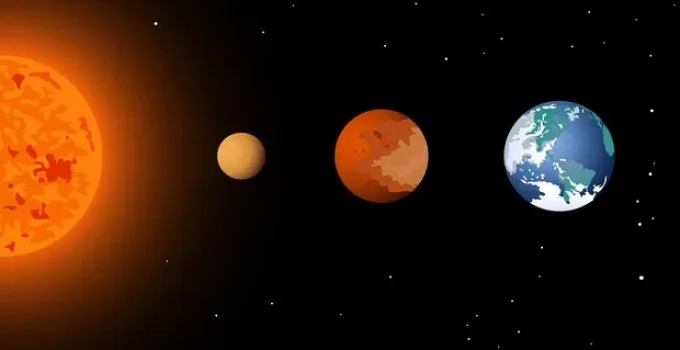Dive Deeper
- 🌍 Is Mercury Bigger Than Earth?
- 📏 Comparing Size and Mass
- 🪨 Mercury’s Dense Interior
- 🪐 Why Mercury Is So Small
- 🔭 What Makes Earth More “Planet-Like”?
- 🎯 Final Thoughts
- 📚 References
🌍 Is Mercury Bigger Than Earth?
No, Mercury is not bigger than Earth. In fact, Mercury is the smallest planet in our entire solar system. Earth is about 2.6 times bigger in diameter and over 18 times more massive than Mercury. If you were to stand on Mercury, the planet beneath your feet would be much smaller, and you would weigh far less than you do on Earth.
Even though Mercury is tiny, it’s still incredibly interesting. It has one of the largest metal cores relative to its size and is one of the densest planets—second only to Earth. Let’s dive into how the two planets compare.
📏 Comparing Size and Mass
Let’s look at the numbers to see how different Mercury and Earth really are:
| Feature | Earth | Mercury |
|---|---|---|
| Diameter | 12,742 km (7,918 mi) | 4,880 km (3,032 mi) |
| Mass | 5.97 x 10²⁴ kg | 3.30 x 10²³ kg |
| Volume | 1 trillion km³ | 60.8 billion km³ |
| Gravity | 9.8 m/s² | 3.7 m/s² |
| Moons | 1 | 0 |
📊 Fun Stat: You could fit about 18 Mercurys inside Earth if you hollowed the planet out [1].
Mercury is smaller than some of Jupiter’s moons, like Ganymede and Callisto, but it’s still considered a planet because it orbits the Sun directly and clears its orbit of debris.
🪨 Mercury’s Dense Interior
Even though Mercury is the smallest planet, it’s also surprisingly dense. That’s because it has a huge iron core that takes up about 85% of the planet’s radius. Earth also has a metallic core, but it’s much smaller compared to the planet’s overall size.
This iron-rich core gives Mercury a high overall density—second only to Earth—because Earth’s gravity compresses its materials more.
| Planet | Density (g/cm³) |
|---|---|
| Earth | 5.51 |
| Mercury | 5.43 |
This high density tells scientists that Mercury is made mostly of heavy materials, especially metals like iron and nickel. Some believe Mercury may have lost its outer rock layers in the early solar system, leaving the heavy core behind.
🪐 Why Mercury Is So Small
There are a few theories about why Mercury ended up so tiny:
- Solar stripping – Mercury may have started larger, but the intense heat and gravity of the nearby Sun could have blown away its outer layers.
- Giant impact – A massive asteroid might have hit Mercury and knocked away part of its crust and mantle.
- Formed from metal-rich materials – Mercury may have formed in a zone of the solar system with more metals and fewer lighter materials.
Because Mercury orbits closest to the Sun, it likely formed in a more harsh and violent region than Earth did. Whatever the cause, the result is a compact, heavy planet with very little atmosphere and no moons.
🔭 What Makes Earth More “Planet-Like”?
While Mercury is a dry, rocky world, Earth is filled with life, water, and air. Here are some key differences that make Earth more complex:
| Feature | Earth | Mercury |
|---|---|---|
| Atmosphere | Thick, rich in oxygen and nitrogen | Very thin exosphere (barely gas) |
| Water | 71% of the surface | Only frozen ice at the poles |
| Temperature | -88°C to 58°C (-126°F to 136°F) | -180°C to 430°C (-290°F to 800°F) |
| Life | Yes | None (as far as we know) |
| Magnetic Field | Strong | Weak, but still present |
🌡️ Fact: Mercury has the biggest temperature swing of any planet—from freezing cold to scorching hot depending on whether it’s facing the Sun or not [2].
So, while Mercury is fascinating and metal-rich, Earth is far more habitable and stable.
🎯 Final Thoughts
Mercury is definitely not bigger than Earth. It’s about one-third the size and much less massive. But what it lacks in size, it makes up for with its massive iron core, dense structure, and extreme environment. It’s a small world with a big personality!
Understanding how Mercury and Earth compare helps scientists learn how rocky planets form—and why only some end up with the right ingredients for life. Mercury may be small, but it plays a big role in our understanding of the solar system.
📚 References
- NASA Solar System Exploration – Mercury: https://solarsystem.nasa.gov/planets/mercury/overview/
- ESA – “Mercury’s Size and Structure”: https://www.esa.int/Science_Exploration/Space_Science/BepiColombo/Mercury
- USGS Planetary Fact Sheet: https://nssdc.gsfc.nasa.gov/planetary/factsheet/
- Denevi, B. W., et al. “MESSENGER Observations of Mercury’s Surface Composition.” Science, 2013.
- Solomon, S. C., et al. “The Core of Mercury: New Results from MESSENGER.” Planetary Science Journal, 2015.
